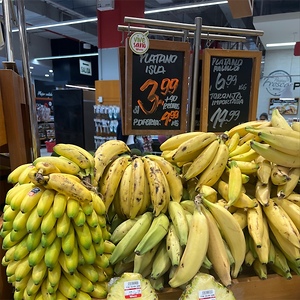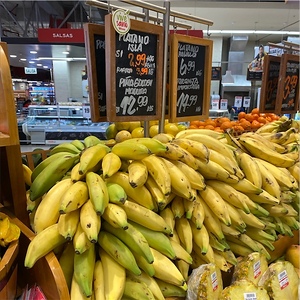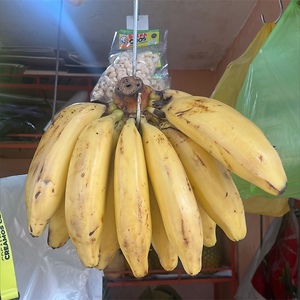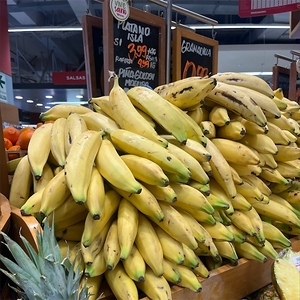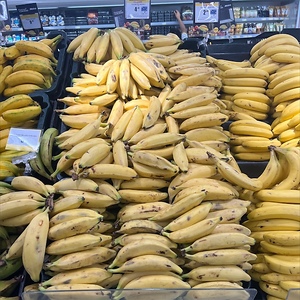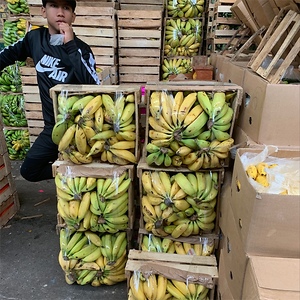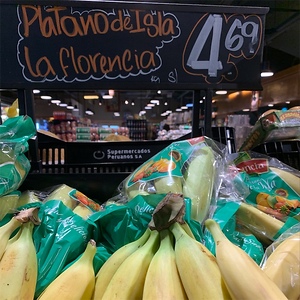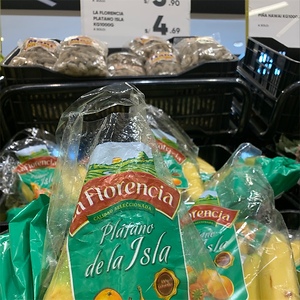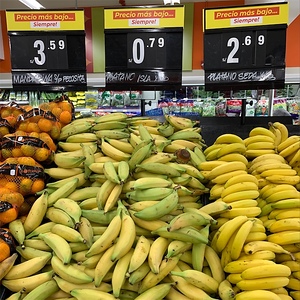

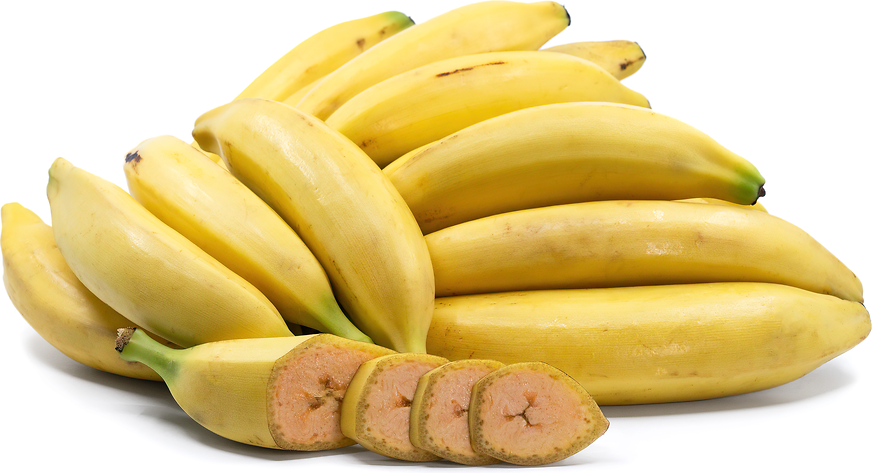
Isla Bananas
Estimated Inventory, lb : 0
Description/Taste
Isla bananas vary in size, depending on their growing region, but generally average 10 to 20 centimeters in length. The bananas have a fairly uniform, cylindrical, tapered shape and may be straight or slightly curved. Some fruits also showcase an angular nature, creating flat faces along the surface. The peel is semi-thick, smooth, lightly striated, and rubbery, ripening from green to shades of golden yellow. As the fruit matures, it also develops dark brown-black markings and streaks. It is worth noting that the peel often changes color before the flesh ripens. Isla bananas reach maturity for consumption as the peel develops brown-black hues. The peel is easily broken open by hand and removed, revealing pigmented flesh with light pink, yellow, and orange hues. The flesh is dense, creamy, soft, and tender, being found seedless or containing unnoticeable, underdeveloped, tiny edible seeds. Isla bananas are edible raw and have a sweet, fragrant, and subtly tangy taste with faint melon and citrus nuances.
Seasons/Availability
Isla bananas are available year-round.
Current Facts
Isla bananas are botanically a part of the Musa genus and are hybrids of Musa acuminata and Musa balbisiana. The species belongs to the Musaceae family and is within the ABB genome and the Pisang Awak subgroup, making the fruits adaptable. Isla bananas are one of the most popular commercial varieties grown and sold throughout Peru, and the fruits are favored for their sweet taste and creamy flesh. INIA, or the National Institute of Agrarian Innovation in Peru, has identified up to seven types of Isla bananas, known as Isleño, Isla Nacional, Isla Guayaquil, Isla de Tingo María, Isla del Alto Huallaga, Isla Maleño, and Isla Vaporino. In most commercial markets, the various types are generally labeled as Isla and are sometimes known as Plátano Isla, as plátano is a term used for both plantains and bananas in Peru. Isla bananas are cultivated and harvested by hand and are widely cultivated throughout coastal and jungle regions. Once harvested, the bananas are sometimes shipped long distances by truck over the Andes mountains to arrive in select commercial markets, and the fruits are sold in large, stacked piles in neighborhood markets, through distributors, and at supermarkets. Isla bananas are revered for their versatility in culinary preparations and can be consumed fresh or cooked in a wide array of sweet or savory dishes.
Nutritional Value
Isla bananas are a source of potassium, which balances fluid levels within the body, vitamin C, which strengthens the immune system, and fiber, which regulates the digestive tract. Bananas also provide calcium to protect and build bones and teeth, vitamin A, which maintains healthy organ functioning, and other nutrients, including folate and vitamin B6. In Peru, Isla bananas are sometimes used as a gentle food in various recipes for babies and consumers with digestive issues.
Applications
Isla bananas have a sweet, subtly fruity taste suited for fresh or cooked preparations. Ripe, raw Isla bananas are popularly eaten out of hand and are valued as a simple snack. It is important to note that the peel turns yellow before the flesh is ripe. Isla bananas are typically ready for fresh consumption when the peel has developed brown-black markings. The variety is also sliced and tossed into fruit salads, breakfast bowls, and porridge, or it can be served on fruit platters. Try blending Isla bananas into smoothies and shakes or pureeing and freezing them into natural popsicles. In addition to fresh preparations, Isla bananas can also be sliced and fried, boiled and served as a side dish to roasted meats and seafood, or baked into crisp chips. When fried, the fruits develop a savory-sweet caramelization on the surface, giving the slices a complex flavoring and chewy texture. Ripe Isla bananas can also be incorporated into muffins, bread, and pancakes, used as a thickener in vegan recipes, or added to puddings and flan. Slices of Isla bananas can be dried for extended use and have a chewy, leathery texture. Isla bananas pair well with meats such as beef, pork, and poultry, spices such as cardamom, cinnamon, and cloves, vanilla, chocolate, and other fruits, including mangos, pineapples, and strawberries. Ripe Isla bananas will keep for 2 to 4 days when stored at room temperature. The fruits should be immediately consumed after their peels darken for the best quality and flavor.
Ethnic/Cultural Info
Isla bananas are notably grown in Mala, Peru, a city in the Cañete province of Southern Lima. Mala is known for banana cultivation, and it is said that the fruits develop a distinct flavor from the unique microclimate found in the region's valleys. Mala is also known for its water and soil, which are filled with high salinity, contributing to the bananas' developing a flavor that is savored when eaten fresh. Isla bananas grown in Mala are sold in markets under names such as Maleño bananas, Isla Maleño, and Plátano Maleño to be distinguished from Isla bananas cultivated in other Peruvian regions. The fruits are left to ripen on the tree in Mala, developing peak flavors, while other regions have to pick their crops early to transport and then artificially ripen the fruits with ethylene. Bananas are widely found throughout Mala, and the region annually celebrates and promotes its crops through a banana festival. The festival was established in 1999 and was created by the District Municipality of Mala to attract tourism, generate awareness of the region’s commercial crops, and promote diversity.
Geography/History
Isla bananas are a prevalent commercial variety in Peru and are hypothesized to have been native to the South Pacific. The variety is thought to descend from bananas growing on Otaheite Island, known in modern times as Tahiti. In 1606, navigator Pedro Fernández de Quiroz, working for the King of Spain, set sail to discover new places that had gold or silver. His ship eventually encountered Otaheite Island, but the navigator left when no valuables were found, leaving behind a small group of settlers to remain on the island. Later, in 1767, British naval officer Samuel Wallis landed on the island and claimed the land for the British, naming it King George Island. The Spanish kingdom felt the island still belonged to them since they landed on it first, leading to conflict between the two kingdoms. Spain eventually sent the Viceroy of Peru, Manuel Amat y Juniet, to reclaim the island, and in 1773, the land was again under Spanish rule, renamed the Island of Viceroy Amat. The Peruvian Viceroy was said to have carried many types of plants he found in the South Pacific back to Peru, and as the island fell under Spanish rule, crops and goods were transported between Peru and the island for many years. Bananas were one of the favored crops introduced from the island, and in Peru, they were initially called the Plátano de la Isla de Amat. Over time, the name was too long and cumbersome for sale in local markets, shortening to become Plátano de la Isla. Today, Isla bananas have remained a choice variety in Peruvian markets and are grown throughout the coastal, jungle, and low-elevation mountainous regions. The bananas can be cultivated up to 1,500 meters in elevation and are sold throughout Peru in local and commercial markets. The Isla bananas featured in the photograph above were sourced through markets in Lima, Peru.



